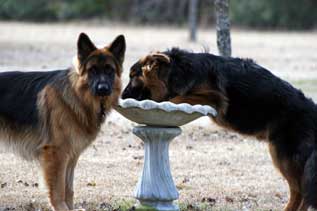Fire Ant Control
Methods Around Pets
Fire Ant Control Methods Around Pets,
This article was reprinted, with permission, from "Fire Ant Control Methods Around Pets (Fire Ant Plan Fact Sheet #014)" published by the Texas Cooperative Extension. Read on to learn even more about how to deal with fire ants - especially when you have pets or children.
The red imported fire ant can be a serious health problem for backyard pets. Fire ants can sting and, occasionally, kill small animals.
According to a recent survey completed by veterinarians, small animals and pets are treated more frequently than any other type of animal for fire ant related health injuries.
Fire ants are commonly attracted to pet food. They can blanket a food bowl, making it impossible for pets to eat. When disturbed, mounds produce thousands of stinging fire ants, creating a potentially dangerous situation for pets while playing, running, or digging near an ant mound.
Very young animals, caged animals, or those that are old and have difficulty moving, are most likely to be stung.
Animals with open sores, hot spots (acute moist dermatitis), irritated
skin, bandaged wounds, or limited mobility from other health problems
are more vulnerable and attractive to fire ants. Such animals are also
more likely to suffer severe reactions because of their weakened state.
Fire ants most readily sting body parts with little or no hair, such as
the muzzle, eyes, ears, and the tender skin of the abdomen. If your pet is attacked, remove him/her as quickly as you can from the source of the fire ants.
Do not attempt to spray the fire ants off with a water hose, since ants will hang on with their jaws and sting repeatedly. Depending on the severity of the attack, treatment by a veterinarian may be necessary.

Fire Ant Control Methods
When applying fire ant control products to areas where pets live, read and follow label instructions for safety and best results. Currently, several conventional and organic treatments exist that can be used outdoors to control fire ants. Be sure to remove your pet from the area when applying any type of product.
Two-step method:
The two-step method can effectively control fire ants in heavily infested areas:
1. Broadcast Applied Baits: Begin the two-step method by broadcasting a fire ant bait (such as Amdro¨, Award¨, Ascend¨, Distance¨, ExtinguishTM, or Eliminator ¨) over the entire yard. When applied properly, broadcast-applied bait products are unlikely to harm pets. This is due to the relative low toxicity of the insecticides used, the small percentage of active ingredient used in baits, and low application rates. When applied at the recommended rate (usually 1 to 1? pounds per acre), baits should be thoroughly scattered so they are barely visible on the ground, and essentially unavailable to contact pets. If the fire ants are active, baits will be rapidly picked up by worker ants and removed to underground nests, away from people, birds, and pets.
2. Individual Mound Treatments: Troublesome mounds near pets or other high-traffic areas are then treated individually with an approved dust, liquid, or granular insecticide plus water. These should be thoroughly watered into the mound and allowed to dry before allowing pets nearby. The use of baits as a mound treatment, or use of granular products without watering-in, may pose a hazard in backyards with pets, as pesticides may remain on the surface in high concentrations where pets can easily contact them.
Individual mound treatments provide quick control of the worst mounds, while the bait treatments provide slower, more complete control of fire ant activity over the whole area.
Fire Ant Control Organic methods:
Several organic methods of controlling fire ants can be safe to
use around your pets. For recently produced mounds, pouring 2 to 3
gallons of very hot or boiling water over the mound will provide 50% to
60% control. Insecticide products containing
pyrethrins
(or a combination pyrethrin plus diatomaceous earth or silica dioxide),
rotenone, pine oil, or d-limonene, can also provide adequate control of
individual fire ant mounds.
Use caution
Despite their relatively low toxicity, caution should always be exercised when applying baits to pet territories. Remove pets during application and take care to sweep up any small piles of spilled bait product. When ingested in large enough quantities, some baits can be toxic to pets so store them properly in a manner to make them inaccessible to pets. Do not leave visible piles of bait on top of fire ant mounds, as this may tempt some pets to feed on the product.
For more information regarding fire ant management, see the Texas Imported Fire Ant Research and Management Project web site at http://fireant.tamu.edu.
© 2004 Drs. Foster and Smith, Inc.
Reprinted as a courtesy and with permission from PetEducation.com (http://www.PetEducation.com)
On-line store at http://www.DrsFosterSmith.com
Free pet supply catalog: 1-800-323-4208
Return from Fire Ant Control to Flea Products
"My husband and I are either going to buy a dog or have a child. We can't decide whether to ruin our carpets or ruin our lives." - Rita Rudner
Sign up for promotions, news, discounts, and the chance to win prizes for you and your German Shepherd
